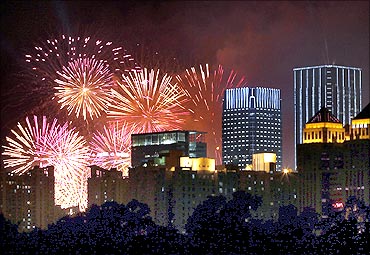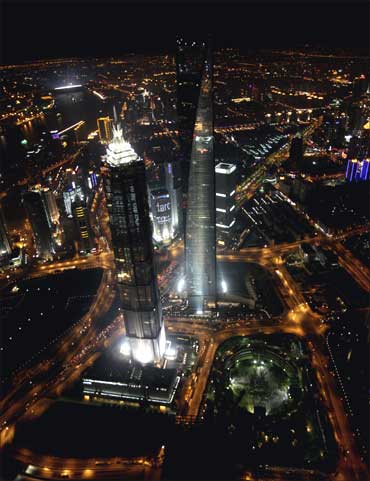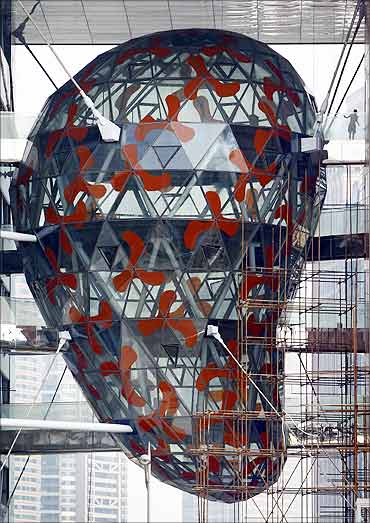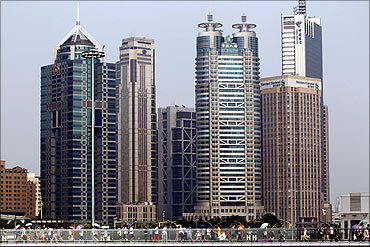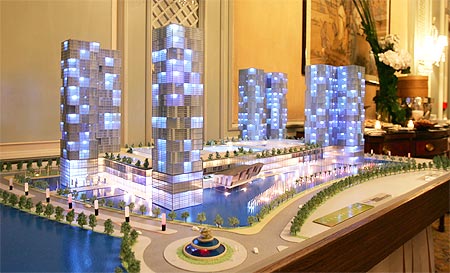 | « Back to article | Print this article |
China creating super-cities, but where are the jobs?
The steel roof of the new exhibition centre can be seen from afar. Spectacularly folded, like a paper umbrella in an exotic cocktail, it suggests big economic development.
In front of the building stands Sun Sihan from the public relations department of Zhengzhou, the capital of Henan province.
She proudly says: "We have the largest conference hall in Asia." Although largely unknown, Zhengzhou is one of the biggest cities in central China, with 4.5 million people.
The bold building is the centre of a huge real estate project, the central business district of Zhengzhou.
A semi-circle of 60 new office towers and apartment houses has mushroomed around an artificial lake. Just east of the existing city is a large area reserved for 'Zhengdong New Town', roughly half the size of Frankfurt.
Click NEXT to read on . . .
China creating super-cities, but where are the jobs?
This agricultural land is becoming a town with factories, offices, apartment houses and shopping centres.
Some city and provincial government departments have already moved into the gleaming new buildings, more than 20 storeys high.
The province has been upgraded and is waiting in its finery for industry from the south to move into the hinterland.
The government has promised to create work in poorer provinces such as Henan, making the tide of workers moving south redundant.
Click NEXT to read on . . .
China creating super-cities, but where are the jobs?
This hope is pegged on companies like Foxconn, currently operating in China's South, employing hundreds of thousands of people.
Foxconn has announced plans to shift much of the production to the hinterland, where up to 400,000 new jobs could be created.
In early August Foxconn had reported the opening of a production site in Zhengzhou.
But the 'opening' was more a PR campaign, possibly an antidote to a series of suicides among migrant workers in the electronics giant's southern Chinese factories.
Click NEXT to read on . . .
China creating super-cities, but where are the jobs?
Now the City Council of Zhengzhou is increasing the pressure. Foxconn has now officially signed a contract for a new factory complex in Zhengzhou.
In one to two years, the factory could be fully operational with about 200,000 workers expected to assemble at least as many iPhones here daily.
Thousands of Henan workers have already applied for jobs -- for lower wages, but closer to home.
Nobody knows which other companies will come out to Zhengzhou. Neither the PR lady nor the officials at the employment centre know.
Click NEXT to read on . . .
China creating super-cities, but where are the jobs?
The taxi drivers have not heard anything, the migrant workers even less. Nor has the Mercedes dealer, Gao Jianshe. His business is nevertheless growing at 80 per cent a year.
The 50-year-old businessman has just opened a new branch for Mercedes passenger vans in Newtown. "No one expected Zhengzhou to develop so quickly, I had a good nose for this."
Gao owns a total of over 100 branches across the country. He maintains a robust optimism: "Those who own the centre of China will soon own the whole country. Historically, it has always been this way."
Who are his customers, though? "Officials, contractors, restaurant owners and many agents of shipping companies," says Gao.
Click NEXT to read on . . .
China creating super-cities, but where are the jobs?
Zhengzhou is situated at the strategic meeting of two important freight routes for Chinese goods. In August, the province broke the 100-million population mark. It now ranks just behind Guangdong, the most populous and richest region of China. But the two provinces are worlds apart.
At about $6,000 per capita, the economic output in Guangdong is double that of Henan. And so the tide of migrants from Henan to the coasts, up to 22 million, continues unabated.
Now the central government wants this economic upswing to penetrate the hinterland. It fears social tensions between the booming coastal regions and the poorer central and west.
The Chinese leadership is serious about addressing the economic imbalance and some Western observers have seen the beginning of the end of the South China growth model.
Click NEXT to read on . . .
China creating super-cities, but where are the jobs?
Gao finds it 'quite natural' that heavyweights such as Foxconn have to relocate their production to Henan, where land and labour is cheap and good transport exists.
"It was unwise of Foxconn, that they have not come earlier. If the production would have shifted earlier, then none would have jumped off a roof in Guangdong," says Gao, referring to recent worker suicides at Foxconn.
For the real estate agents, however, having the likes of Foxconn close by is a main selling point. Prices are exploding: flats in the new buildings are 40 per cent more expensive than in the old city.
"Ordinary Zhengzhou residents such as myself cannot afford this. We need to stay in the old city centre," says taxi driver Cai Jie, speaking for many people. Even the optimistic Gao acknowledges that the real estate market is "overheating slightly".
Click NEXT to read on . . .
China creating super-cities, but where are the jobs?
Leslie Chang, author of an acclaimed book on social structures in the southern Chinese mega-factories, does not believe in an end to the southern Chinese growth model. The recent strikes at Honda are an 'atypical case' rather than the beginning of an ongoing trend.
Chang concludes that China's migrant workers constitute a valve function for their country. In times of prosperity they flock to the factories allowing a rapid increase in production. In times of crisis, they go back to the country and survive on odd jobs until the next economic high.
The one problem with trying to balance the growth areas in China is that the Newtown in Zhengzhou is no exception.
There are countless such projects, says Patrick Chovanec, an economist at Beijing's Qinghua University, who has studied industrial parks in secondary Chinese cities for years. "They're all 10 years ahead of their needs."
Click NEXT to read on . . .
China creating super-cities, but where are the jobs?
And despite the excellent infrastructure connection, Zhengzhou cannot compete with the Guangdong industrial cities, which lie close to container ports.
There are also economic factors: given the uncertain outlook for the US economy, many producers are reluctant to undertake major investments.
Auto dealer Gao is not moved by these arguments. "We are the hub for all of central China. The Newtown will be a great success one day." But when is that day?
Meanwhile, construction continues undeterred in Zhengzhou. Approximately $4 billion was pumped by the provincial and municipal government into the Newtown project.
Frank Sieren is a bestselling author who has been living in Beijing for 15 years and is one of the leading German experts on China. His brother Andreas is a journalist and specialist in international relations and development aid, who has worked for many years for the United Nations in Asia and Africa.


